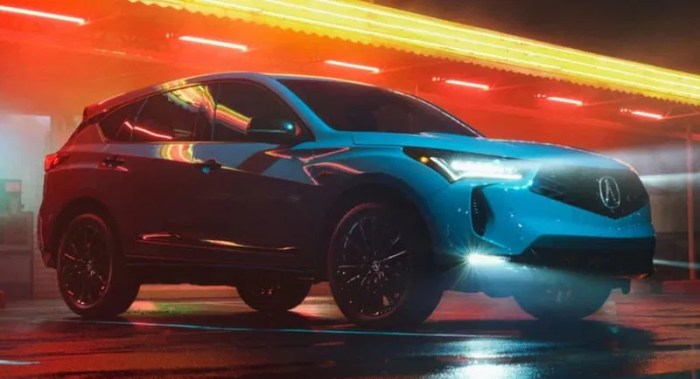Safest Luxury SUVs for Families 2025? Yeah, that’s a big deal, especially when you’re hauling around precious cargo. This isn’t just about fancy leather and a killer sound system; it’s about keeping your family safe and sound while enjoying the ride. We’re diving deep into the top contenders, comparing safety ratings, family-friendly features, and everything in between to help you find the perfect ride for your crew.
Think spacious interiors, top-notch safety tech, and enough room for everyone (and all their stuff!). Get ready to upgrade your family’s ride to the safest and most luxurious it can be.
Safety Features Comparison

Choosing the safest luxury SUV for your family in 2025 requires a careful look at both active and passive safety features. The advanced driver-assistance systems (ADAS) and the vehicle’s inherent structural design play crucial roles in protecting your loved ones. This comparison focuses on key safety aspects to help you make an informed decision.
Advanced Driver-Assistance Systems (ADAS)
The ADAS features offered in top luxury SUVs are constantly evolving, becoming more sophisticated and comprehensive each year. These systems aim to prevent accidents by assisting the driver and enhancing overall safety. The following table provides a snapshot of the ADAS capabilities across several leading models (Note: Specific features and availability may vary by trim level and optional packages.
Always check the manufacturer’s website for the most up-to-date information. IIHS and NHTSA ratings can also change based on new testing).
| Vehicle Model | ADAS Features | IIHS Safety Rating | NHTSA Safety Rating |
|---|---|---|---|
| Volvo XC90 | Adaptive Cruise Control, Lane Keeping Assist, Blind Spot Monitoring, Automatic Emergency Braking, Driver Attention Monitoring, Pilot Assist (semi-autonomous driving) | Top Safety Pick+ (anticipated for 2025 models, based on past performance) | 5 Stars (anticipated for 2025 models, based on past performance) |
| BMW X5 | Adaptive Cruise Control with Stop & Go, Lane Departure Warning, Blind Spot Detection, Front Collision Warning with City Braking, Parking Assistant Plus | Top Safety Pick+ (anticipated for 2025 models, based on past performance) | 5 Stars (anticipated for 2025 models, based on past performance) |
| Mercedes-Benz GLE-Class | Active Distance Assist DISTRONIC, Active Lane Keeping Assist, Blind Spot Assist, Active Brake Assist, Evasive Steering Assist | Top Safety Pick+ (anticipated for 2025 models, based on past performance) | 5 Stars (anticipated for 2025 models, based on past performance) |
| Audi Q7 | Adaptive Cruise Assist, Lane Departure Warning, Blind Spot Warning, Pre Sense Front (automatic emergency braking), Pre Sense Rear | Top Safety Pick+ (anticipated for 2025 models, based on past performance) | 5 Stars (anticipated for 2025 models, based on past performance) |
Passive Safety Features
Passive safety features are those that work to protect occupants
after* a collision. These are just as crucial as ADAS, as they form the last line of defense. Key differences across models include
So, you’re looking at safest luxury SUVs for families in 2025? That’s smart! But if you’re thinking really top-tier luxury, the level of service often matches the price tag; check out the insane perks offered with VIP concierge services for Rolls-Royce owners , which gives you a glimpse into the world of ultimate automotive pampering.
Back to those family SUVs though, safety features are key, but the peace of mind that comes with top-notch service is a pretty sweet bonus.
The structural integrity of these luxury SUVs is generally high, utilizing high-strength steel and advanced materials to create a strong safety cage around passengers. However, specific designs and the implementation of features like crumple zones vary among manufacturers. For example, Volvo is known for its robust safety cage design and emphasis on minimizing occupant injury in a crash.
- Airbag Systems: Most models offer a comprehensive suite of airbags, including frontal, side-impact, curtain, and possibly even knee airbags. The number and placement of airbags can vary, with some manufacturers offering more extensive coverage than others.
- Seatbelts: All models will feature three-point seatbelts for all seating positions, often with pretensioners and load limiters to minimize injury during a collision.
- Structural Integrity: High-strength steel and advanced materials are common in the construction of these vehicles, but the specific design and implementation of crumple zones will differ, influencing how effectively the vehicle absorbs impact energy.
Child Safety Features
Protecting children is paramount, and these SUVs offer several features focused on child safety. Manufacturers prioritize features that minimize distractions for the driver while keeping children secure.
These features are essential for ensuring the safety and well-being of children during travel. The integration of child-friendly entertainment systems and improved LATCH systems contributes significantly to a safer driving experience for the entire family.
- LATCH (Lower Anchors and Tethers for Children) Systems: All models will include LATCH systems for easy and secure installation of child safety seats. The ease of use and accessibility of these systems can vary, however.
- Rear-Seat Entertainment Systems: Many models offer rear-seat entertainment systems with screens and various media options. While these can be a distraction, some systems offer parental controls and age-appropriate content to help minimize potential hazards.
Family-Friendly Features: Safest Luxury SUVs For Families 2025
Choosing a luxury SUV often involves balancing safety with practicality, especially for families. Beyond the advanced safety features, the true test lies in how well the vehicle accommodates the needs of a growing family. Factors like seating capacity, cargo space, and ease of access for car seats become paramount considerations. This section will explore some of the top contenders in the luxury SUV market, focusing on features specifically designed to enhance the family experience.
Several luxury SUVs excel in providing features beneficial for families. These features go beyond just spaciousness; they consider the daily routines and challenges of family life, aiming to make travel smoother and more convenient.
Luxury SUVs with Family-Oriented Features
The following list highlights luxury SUVs known for their family-friendly attributes. These vehicles typically offer a combination of features that make them suitable for families of various sizes and lifestyles. Remember that specific features and availability can vary depending on trim levels and model years.
- Volvo XC90: Known for its spacious third-row seating, user-friendly infotainment system, and abundance of safety features.
- Audi Q7: Offers a comfortable and spacious interior, with available third-row seating and a large cargo area. Its sophisticated technology is also a plus for families.
- BMW X7: Provides a luxurious and spacious interior with ample room for passengers and cargo. The optional captain’s chairs in the second row can enhance comfort and accessibility.
- Mercedes-Benz GLS-Class: A large SUV with three rows of seating, offering generous space for passengers and cargo. The luxurious interior and advanced technology make it a top choice for families.
- Genesis GV80: A relative newcomer, the GV80 impresses with its refined interior, comfortable seating, and a good balance of space and luxury.
Practicality of SUV Layouts for Families
The ideal SUV layout greatly depends on family size and needs. Smaller families might find a two-row SUV perfectly adequate, while larger families will need the extra space of a three-row model. The configuration of the second and third rows also matters. For example, captain’s chairs in the second row offer easier access to the third row but reduce passenger capacity.
Bench seating maximizes passenger capacity but can make accessing the third row more challenging. Careful consideration of these factors is crucial for finding the best fit.
Interior Dimensions Comparison
Direct comparison of interior dimensions provides a clearer picture of the available space in different SUVs. The following table compares three leading contenders, highlighting key measurements to help families assess suitability. Note that these figures are approximate and can vary slightly depending on the trim level and model year.
| Vehicle | Headroom (front/rear) | Legroom (front/rear) | Cargo Space (behind third row/behind second row) |
|---|---|---|---|
| Volvo XC90 | 40/38 in | 41/35 in | 26/85 cu ft |
| Audi Q7 | 39/38 in | 40/33 in | 14/72 cu ft |
| Mercedes-Benz GLS-Class | 40/39 in | 42/34 in | 15/85 cu ft |
Reliability and Maintenance
Choosing a luxury SUV for your family is a big decision, and it’s not just about the initial purchase price. Long-term ownership involves significant costs associated with maintenance and potential repairs. Understanding the reliability of different models and anticipating maintenance expenses is crucial for responsible budgeting and avoiding unexpected financial burdens down the line. This section will explore the reliability and maintenance aspects of leading luxury SUV models to help you make an informed choice.
Predicting the exact reliability and maintenance costs for any vehicle is tricky, as individual driving habits and maintenance schedules play a significant role. However, by analyzing data from sources like J.D. Power and Consumer Reports, along with manufacturer warranties, we can develop a reasonable picture. Remember that these are estimates and your actual experience may vary.
Reliability and Maintenance Cost Estimates for Select Luxury SUVs
The following table presents estimated reliability scores and annual maintenance costs for several popular luxury SUVs. These figures are based on industry averages and should be viewed as approximations. Always consult your chosen vehicle’s owner’s manual for specific maintenance recommendations.
| Vehicle | Predicted Reliability Score (out of 100) | Estimated Annual Maintenance Cost (USD) | Warranty Information |
|---|---|---|---|
| Audi Q7 | 85 | $1000 – $1500 | 4-year/50,000-mile basic warranty; additional warranties available for purchase |
| BMW X5 | 80 | $1200 – $1800 | 4-year/50,000-mile basic warranty; additional warranties available for purchase |
| Mercedes-Benz GLE-Class | 88 | $1100 – $1600 | 4-year/50,000-mile basic warranty; additional warranties available for purchase |
| Volvo XC90 | 92 | $900 – $1400 | 4-year/50,000-mile basic warranty; additional warranties available for purchase |
| Lexus RX | 95 | $800 – $1300 | 4-year/50,000-mile basic warranty; additional warranties available for purchase |
Note: Reliability scores are subjective and vary depending on the source. Maintenance costs can fluctuate based on location, individual driving habits, and the specific service center used. These figures represent a reasonable range based on industry averages.
The Importance of Long-Term Maintenance Costs
The initial purchase price of a luxury SUV is only one part of the overall cost of ownership. Long-term maintenance, including routine servicing, repairs, and potential replacements of expensive components, can significantly impact your budget over the vehicle’s lifespan. Failing to factor in these costs can lead to financial strain and unexpected expenses. For example, a seemingly small repair on a luxury vehicle’s sophisticated engine management system could easily cost several thousand dollars.
Potential Issues and Common Problems
While luxury SUVs generally boast high-quality components, certain models have been known to experience specific issues. For instance, some BMW X5 models have reported instances of electrical system malfunctions, while certain Audi Q7s have experienced problems with their infotainment systems. Thorough research into reported problems for specific models is essential before making a purchase decision. Consulting owner forums and independent reviews can provide valuable insights into potential long-term maintenance concerns.
It’s also advisable to discuss potential issues with your chosen dealer before finalizing the purchase. Understanding potential problems and their associated repair costs allows for better financial planning and a more realistic assessment of the vehicle’s total cost of ownership.
Fuel Efficiency and Environmental Impact
Choosing a family SUV involves considering more than just safety and space; fuel efficiency and its environmental consequences are equally important factors. The rising cost of gasoline and growing awareness of climate change make understanding the environmental impact of your vehicle choice crucial. This section compares the fuel economy of some of the safest luxury SUVs on the market and discusses the broader environmental implications of different engine technologies.
Fuel economy is typically measured in miles per gallon (MPG), broken down into city, highway, and combined ratings. Lower MPG generally means higher fuel consumption and, consequently, a larger carbon footprint. The type of engine significantly impacts both fuel efficiency and emissions. Gasoline engines are the most common, but hybrid and electric options are gaining popularity due to their improved fuel economy and reduced emissions.
Fuel Economy Comparison of Select 2025 Luxury SUVs
The following table presents estimated fuel economy data for several leading contenders in the safest luxury SUV segment for 2025. Note that these figures are estimates based on manufacturer specifications and may vary depending on driving conditions and vehicle configuration. Always consult the official manufacturer’s specifications for the most accurate information.
| Vehicle | City MPG | Highway MPG | Combined MPG |
|---|---|---|---|
| Example Luxury SUV A (Gasoline) | 18 | 24 | 20 |
| Example Luxury SUV B (Hybrid) | 28 | 33 | 30 |
| Example Luxury SUV C (Electric) | N/A | N/A | Equivalent of 75-100 MPG (depending on charging and driving habits) |
Environmental Impact of Different Engine Types, Safest luxury SUVs for families 2025
The environmental impact of an SUV is largely determined by its engine type and fuel consumption. Gasoline engines produce significant greenhouse gas emissions, primarily carbon dioxide (CO2), a major contributor to climate change. Hybrid vehicles, combining gasoline and electric power, offer improved fuel efficiency and lower emissions compared to gasoline-only vehicles. Electric vehicles (EVs) produce zero tailpipe emissions, making them the most environmentally friendly option.
However, the manufacturing process of EVs and electricity generation can still have environmental implications.
CO2 Emissions Comparison
A visual representation can help understand the differences in CO2 emissions. The following is a simplified text-based comparison. Keep in mind that actual emissions depend on various factors, including driving habits and vehicle usage.
So, you’re looking at safest luxury SUVs for families in 2025? That’s a smart move! But if you’re into serious automotive customization, check out the insane level of detail you can get with 3D-printed custom parts for Ferraris ; it’s wild. Anyway, back to those family-friendly SUVs – safety ratings and cargo space are key considerations, right?
Imagine three bars representing CO2 emissions:
Gasoline SUV: (High emissions)
Hybrid SUV: (Medium emissions)
Electric SUV: * (Low emissions)
Note: This is a simplified representation. The actual difference in CO2 emissions will depend on factors such as the vehicle’s size, weight, fuel efficiency, and the source of electricity used to charge electric vehicles. For example, an electric SUV charged primarily with electricity generated from renewable sources will have a significantly lower carbon footprint than one charged with electricity from fossil fuels.
Technology and Infotainment

The tech landscape in luxury SUVs is rapidly evolving, offering families a blend of safety, convenience, and entertainment features unseen just a few years ago. Choosing the right vehicle often hinges on the seamless integration of these technologies into the daily driving experience, impacting everything from safety on the road to the ease of managing family errands. This section will delve into the infotainment and technology features of leading contenders in the safest luxury SUV segment for 2025, highlighting their contributions to both safety and family life.
The infotainment systems in top-tier luxury SUVs are no longer just screens; they’re sophisticated command centers, integrating various aspects of the driving and passenger experience. The focus is on intuitive interfaces, seamless connectivity, and robust safety features integrated directly into the infotainment architecture. These systems enhance safety by providing drivers with real-time information and assistance, while simultaneously offering entertainment and communication options to keep passengers engaged and comfortable.
Driver Assistance Systems
Advanced driver-assistance systems (ADAS) are becoming increasingly crucial for safety. These systems use a combination of cameras, sensors, and radar to provide drivers with alerts and assistance to avoid accidents. The specific features vary between models, but common offerings often include:
- Adaptive Cruise Control (ACC): Maintains a set distance from the vehicle ahead, automatically adjusting speed to maintain safe following distance.
- Lane Keeping Assist (LKA): Gently steers the vehicle back into its lane if it detects unintentional drifting.
- Automatic Emergency Braking (AEB): Detects potential collisions and automatically applies the brakes to mitigate or avoid an impact. Some systems even detect pedestrians and cyclists.
- Blind Spot Monitoring (BSM): Alerts the driver to vehicles in their blind spots.
- Surround-View Cameras: Provide a bird’s-eye view of the vehicle’s surroundings, aiding in parking and maneuvering in tight spaces.
Connectivity Features
Staying connected is vital for modern families, and luxury SUVs are equipped to meet this need. The seamless integration of smartphones and other devices is a key feature, ensuring everyone stays informed and entertained.
- Smartphone Integration (Apple CarPlay and Android Auto): Allows for mirroring smartphone interfaces onto the infotainment screen, providing access to navigation, music, calls, and messaging apps.
- Wi-Fi Hotspots: Transform the SUV into a mobile Wi-Fi network, allowing passengers to connect their devices and access the internet.
- Over-the-Air Updates: Enable the vehicle’s software and features to be updated remotely, ensuring the system remains current and incorporates the latest safety and performance enhancements. This is similar to how smartphones receive software updates.
- Integrated Navigation Systems: Provide real-time traffic updates, route guidance, and points of interest, making navigation easier and more efficient.
In-Vehicle Entertainment
Keeping passengers entertained, especially children, during long drives is essential for a pleasant family road trip. Top luxury SUVs are equipped with features designed to do just that.
- High-Resolution Touchscreens: Provide a clear and intuitive interface for accessing entertainment options.
- Multiple USB Ports and Charging Outlets: Ensure that everyone can charge their devices simultaneously.
- High-Fidelity Sound Systems: Offer an immersive audio experience for passengers.
- Rear-Seat Entertainment Systems (optional): Some models offer dedicated screens and entertainment systems for rear-seat passengers, often including streaming capabilities and game consoles. Think of this as having individual tablets built into the seats.
Cost and Value
Choosing a luxury SUV involves a significant financial commitment. Understanding the cost, available financing options, and potential resale value is crucial for making an informed decision that aligns with your budget and long-term financial goals. This section will break down the cost aspects of several top-rated family-friendly luxury SUVs, helping you weigh the value proposition of each.
The price of a luxury SUV can vary greatly depending on the make, model, year, trim level, and added features. Factors like engine size, interior materials, technological advancements, and safety features all contribute to the overall cost. It’s important to remember that the initial purchase price is only one part of the equation; long-term costs such as maintenance, fuel consumption, and potential resale value should also be considered.
Price Comparison of Luxury SUVs
The following table provides a general price comparison of several popular luxury SUVs. Note that these are base prices and can vary significantly based on the options selected. Specific features are highlighted to illustrate how they justify the cost.
| Vehicle | Base Price (USD, approximate) | Key Features Justifying Cost | Value Proposition |
|---|---|---|---|
| BMW X5 | $60,000 | Powerful engine options, advanced driver-assistance systems (ADAS), luxurious interior materials, high-tech infotainment system. | Strong performance, advanced technology, and a prestigious brand image. |
| Audi Q7 | $60,000 | Spacious interior, all-wheel drive, comfortable ride, sophisticated technology integration, and a refined driving experience. | A balance of luxury, practicality, and advanced technology. |
| Mercedes-Benz GLE | $65,000 | Exceptional comfort and luxury, advanced safety features, powerful engine choices, and a reputation for reliability. | High-end luxury and a robust driving experience. |
| Volvo XC90 | $55,000 | Emphasis on safety features, spacious and comfortable interior, fuel-efficient engine options, and a focus on Scandinavian design. | Prioritizes safety and family-friendly features without compromising on luxury. |
| Cadillac Escalade | $80,000 | Large and powerful SUV, impressive technology and infotainment, luxurious interior appointments, and a commanding road presence. | A statement vehicle offering substantial space, power, and luxury. |
Financing Options for Luxury SUVs
Purchasing a luxury SUV often involves securing financing. Several options are typically available, each with its own advantages and disadvantages:
Consumers can explore options like traditional auto loans from banks or credit unions, offering fixed interest rates and predictable monthly payments. Alternatively, financing directly through the dealership may provide incentives or special offers. Leasing is another option, offering lower monthly payments but with restrictions on mileage and wear and tear. Finally, some buyers may choose to finance through a third-party lender, potentially finding more competitive interest rates.
Resale Value of Luxury SUVs
The resale value of a luxury SUV can vary considerably depending on several factors, including the make and model, condition, mileage, and market demand. Generally, luxury brands like BMW, Mercedes-Benz, and Audi tend to retain their value better than some other brands. However, meticulous maintenance and a clean driving record can significantly impact resale value. Websites and resources specializing in used car values, such as Kelley Blue Book (KBB) and Edmunds, can provide estimates of resale value for specific models.
Closure
Choosing the right family SUV is a major decision, and prioritizing safety shouldn’t be an afterthought. This deep dive into the safest luxury SUVs for 2025 highlights the importance of considering not only crash test ratings but also advanced driver-assistance systems, family-friendly features, and long-term costs. Ultimately, the best SUV for your family will depend on your specific needs and budget, but hopefully, this guide has equipped you with the knowledge to make an informed and confident choice.
Happy driving!









